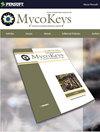Phylogenetic classification of arbuscular mycorrhizal fungi: new species and higher-ranking taxa in Glomeromycota and Mucoromycota (class Endogonomycetes)
IF 2.8
2区 生物学
Q2 MYCOLOGY
引用次数: 0
Abstract
Arbuscular mycorrhizal (AM) fungi - Glomeromycota and Endogonomycetes - comprise multiple species and higher-level taxa that have remained undescribed. We propose a mixed morphology- and DNA-based classification framework to promote taxonomic communication and shed light into the phylogenetic structure of these ecologically essential fungi. Based on eDNA samples and long reads as type materials, we describe 15 new species and corresponding genera (Pseudoentrophospora kesseensis, Hoforsa rebekkae, Kahvena rebeccae, Kelottijaervia shannonae, Kungsaengena shadiae, Langduoa dianae, Lehetua indrekii, Lokruma stenii, Moostea stephanieae, Nikkaluokta mahdiehiae, Parnigua craigii, Riederberga sylviae, Ruua coralieae, Tammsaarea vivikae and Unemaeea nathalieae), the genus Parvocarpum as well as 19 families (Pseudoentrophosporaceae, Hoforsaceae, Kahvenaceae, Kelottijaerviaceae, Kungsaengenaceae, Langduoaceae, Lehetuaceae, Lokrumaceae, Moosteaceae, Nikkaluoktaceae, Parniguaceae, Riederbergaceae, Ruuaceae, Tammsaareaceae, Unemaeeaceae, Bifigurataceae, Planticonsortiaceae, Jimgerdemanniaceae and Vinositunicaceae) and 17 orders (Hoforsales, Kahvenales, Kelottijaerviales, Kungsaengenales, Langduoales, Lehetuales, Lokrumales, Moosteales, Nikkaluoktales, Parniguales, Riederbergales, Ruuales, Tammsaareales, Unemaeeales, Bifiguratales and Densosporales), and propose six combinations (Diversispora bareae, Diversispora nevadensis, Fuscutata cerradensis, Fuscutata reticulata, Viscospora deserticola and Parvocarpum badium) based on phylogenetic evidence. We highlight further knowledge gaps in the phylogenetic structure of AM fungi and propose an alphanumeric coding system for preliminary communication and reference-based eDNA quality-filtering of the remaining undescribed genus- and family-level groups. Using AM fungi as examples, we hope to offer a sound, mixed framework for classification to boost research in the alpha taxonomy of fungi, especially the “dark matter fungi”.丛枝菌根真菌的系统发育分类:球菌门(Glomeromycota)和粘菌门(Mucoromycota)(Endogonomycetes 类)中的新种和高等类群
丛枝菌根(AM)真菌(Glomeromycota 和 Endogonomycetes)包括多个尚未描述的物种和更高层次的类群。我们提出了一个基于形态学和 DNA 的混合分类框架,以促进分类学交流,并揭示这些生态上不可或缺的真菌的系统发育结构。基于 eDNA 样本和长读数作为模式材料,我们描述了 15 个新种和相应的属(Pseudoentrophospora kesseensis、Hoforsa rebekkae、Kahvena rebeccae、Kelottijaervia shannonae、Kungsaengena shadiae、Langduoa dianae、Lehetua indrekii、Lokruma stenii、Moostea stephanieae、Nikkaluokta mahdie、Nikkaluokta mahdie、Nikkaluokta mahdie、Nikkaluokta mahdie、Nikkaluokta mahdie)、Nikkaluokta mahdiehiae、Parnigua craigii、Riederberga sylviae、Ruua coralieae、Tammsaarea vivikae 和 Unemaeea nathalieae)、Parvocarpum 属以及 19 个科(Pseudoentrophosporaceae、Hoforsaceae、Kahvenaceae、Kelottijaerviaceae、Kungsaengenaceae、Langduoaceae、Lehetuaceae、Lokrumaceae、Moosteaceae、(Nikkaluoktaceae、Parniguaceae、Riederbergaceae、Ruaceae、Tammsaareaceae、Unemaeeaceae、Bifigurataceae、Planticonsortiaceae、Jimgerdemanniaceae 和 Vinositunicaceae) 和 17 个目(Hoforsales、Kahvenales、Kelottijaerviales、Kungsaengenales、Langduoales、Lehetuales、Lokrumales、Moosteales、Nikkaluoktales、Parniguales、Riederbergaceae、Ruaceae、Tammsaareaceae、Unemaeeaceae、Bifigurataceae、Planticonsortiaceae、Jimgerdemanniaceae 和 Vinositunicaceae)、Parniguales、Riederbergales、Ruuales、Tammsaareales、Unemaeeales、Bifiguratales 和 Densosporales),并根据系统发育证据提出了六个组合(Diversispora bareae、Diversispora nevadensis、Fuscutata cerradensis、Fuscutata reticulata、Viscospora deserticola 和 Parvocarpum badium)。我们强调了在上午真菌系统发育结构方面存在的进一步知识差距,并提出了一种字母数字编码系统,用于初步交流和基于参考的 eDNA 质量筛选剩余的未描述属级和科级类群。我们希望以AM真菌为例,提供一个完善的混合分类框架,以促进真菌阿尔法分类学的研究,尤其是 "暗物质真菌 "的研究。
本文章由计算机程序翻译,如有差异,请以英文原文为准。
求助全文
约1分钟内获得全文
求助全文
来源期刊

Mycokeys
MYCOLOGY-
CiteScore
5.90
自引率
12.10%
发文量
66
审稿时长
6 weeks
期刊介绍:
MycoKeys is a peer-reviewed, open-access, online and print, rapidly produced journal launched to support free exchange of ideas and information in systematics and biology of fungi (including lichens).
All papers published in MycoKeys can be freely copied, downloaded, printed and distributed at no charge for the reader. Authors are thus encouraged to post the pdf files of published papers on their homepages or elsewhere to expedite distribution. There are no restrictions nor charge for color.
 求助内容:
求助内容: 应助结果提醒方式:
应助结果提醒方式:


